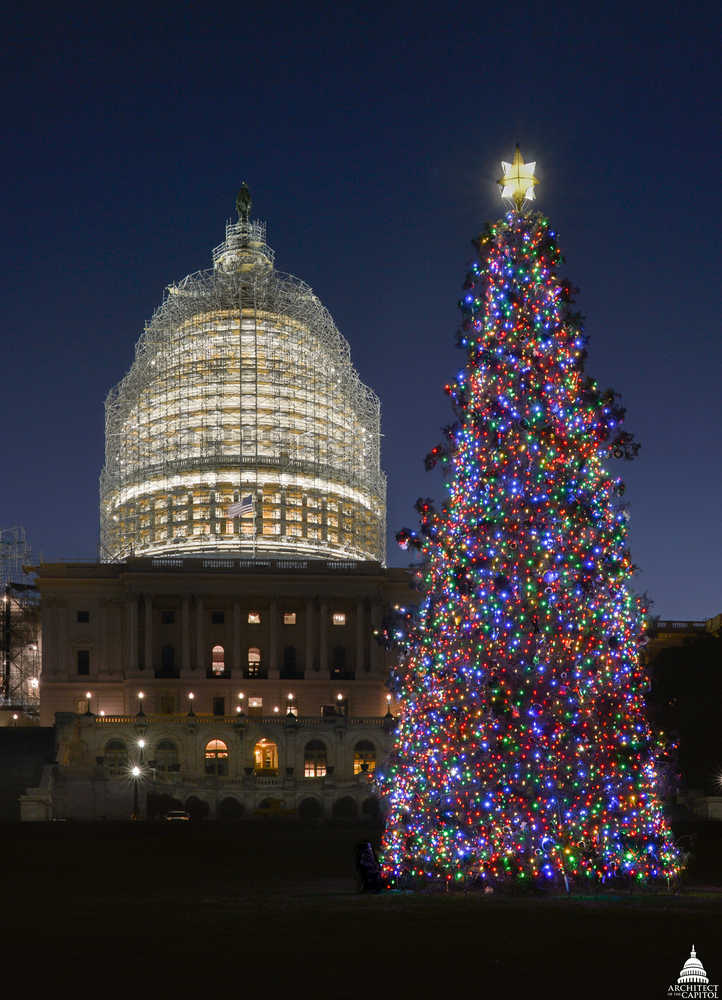On this Christmas Eve, most of us have an ornamented tree of one sort or another in our house, a tradition that goes back at least to the 1500s in Europe and one that was firmly established in most U.S. households by 1920. Most of us also know that Alaska provided the Capitol Christmas Tree that stands outside the White House, a gift from the Chugach National Forest and celebrated in the essay by fifth-grader Anna DeVolld from Soldotna. What an incredible story and what an incredible tree! A more than 90-year-old, 74-foot, giant Lutz spruce—a what?!
Designating the Capitol Christmas Tree has been a formal process since 1964 and, beginning in 1970, these trees have all originated from our National Forests. In the last 51 years, there have been 2 white pines, 19 firs representing 8 species, and 30 spruce representing 8 species. This year’s Capitol Christmas Tree is the first from Alaska and the first Lutz spruce.
Lutz spruce is the natural hybrid between Sitka (Picea sitchensis) and white spruce (Picea glauca). Sitka spruce grows in our coastal rainforest from the eastern Kenai Peninsula to northern California, preferring a maritime climate with moderate temperatures and lots of rain. White spruce grows from the western Kenai Peninsula across Interior Alaska to Newfoundland, preferring a continental climate with extreme temperatures and low precipitation.
Here on the Kenai Peninsula, the rainshadow created by the Kenai Mountains creates unique climate variations where cooler temperatures intersect with moderate rainfall. You can find this microclimate along the Resurrection Trail, sections of the Seward Highway and in Caribou Hills. In the summers of 1950 and 1951, Harold John Lutz collected specimens from Jerome and Kenai Lakes near Cooper Landing that he recognized as a hybrid between the two spruce species. These specimens were subsequently confirmed as a hybrid by Elbert Little of the U.S. Forest Service in 1953, who formally named it “Picea X lutzii” in honor of Lutz.
Who was Lutz? He didn’t just stumble across this conifer and take a lucky guess as to its taxonomy. Dr. Lutz was a professor in the Yale School of Forestry from 1933 to 1968. Early in his career he conducted research for the U.S. Forest Service in Alaska.
Lutz spruce is of interest here on the Kenai because it appears to be more susceptible to mortality from a spruce bark beetle attack than either parental species. Dr. John Alden, a retired forest geneticist still affiliated with the University of Alaska Fairbanks, studied Lutz and its distribution here on the Kenai. He remains convinced that most of the forest that experienced 100% mortality in the Caribou Hills from Homer to Ninilchik as a result of the spruce bark beetle epidemic during the late 1980s and 1990s was Lutz spruce.
Alden developed a method for classifying the degree of introgression (or hybridization) based on foliage and cone characteristics on a scale from 1 (white) to 7 (Sitka). Forest Service experts used this classification to determine that the tree cut near Primrose off the Seward Highway, now standing in Washington D.C., was indeed a Lutz spruce, scoring a 5 or 6.
Dr. Rob DeVelice, one of the taxonomic experts consulted, was also one of the individuals involved in identifying 28 species of lichens that grew on this particular tree—a tree that was likely just sprouting as the tracks for the nascent Alaska Railroad, half a mile away, were being laid between Seward and Turnagain Arm in the early 1900s. It is truly amazing that a single tree can harbor this much biodiversity.
Wade Wahrenbrock, Kenai Peninsula Borough forester, tells me that Lutz spruce from the Kenai Peninsula has been widely used as stock to grow forests in Iceland, of all places! Whether it’s the similarity of the climate or soils between our peninsula and their island, our native Lutz has been a founding species in Iceland’s decades-old efforts to afforest its otherwise stark landscape.
Enjoy your family and gifts this Christmas—but give some thought to the tree that stands in your house and the giant Lutz that was trucked 4,000 miles to represent Alaska and the Kenai this holiday.
Dr. John Morton is the supervisory biologist at Kenai National Wildlife Refuge. Find more information at http://www.fws.gov/refuge/kenai/ or http://www.facebook.com/kenainationalwildliferefuge.

